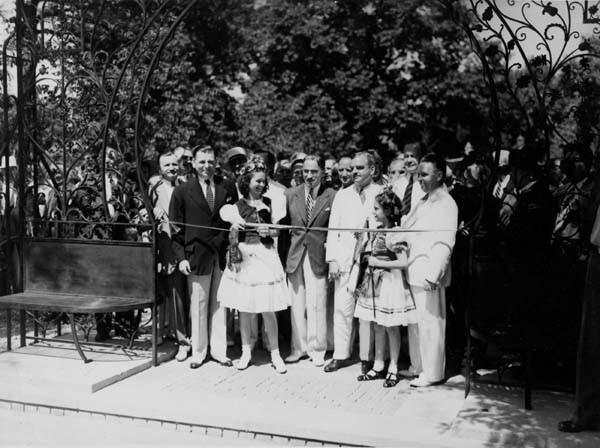Hungarian Cultural Garden

The Hungarian Cultural Garden began with the dedication of a bas-relief to composer Franz Liszt (1811-1886) on the site in 1934; it was completed and formally dedicated in 1938. The Garden is constructed on two levels along the upper boulevard, and overlooks lower East Boulevard. Designed by a well-known architect of Budapest, Hungary, its design is distinguished by a compact, opulent, and formal landscape style. The original design and intentions have been well maintained, with hedges cut to a larger size. This lends the spaces a contemplative feel of discovery.
The Hungarian population's first significant immigration to Cleveland began in the 1870s. The Buckeye Rd. neighborhood, on the easternmost edge of the city at that time, was the first Hungarian settlement area. A separate settlement arose in the 1880s between Madison St. (now E. 79th) and E. 65th St. along the south-side of Woodland Ave. The largest wave of Hungarian immigration occurred between 1870 and 1924. In 1900 the U.S. Census recorded 9,558 Hungarians (or 8% of the city's foreign born population) in Cleveland. By 1920 this number was 43,134 (18%). During these years Hungarians would come to Cleveland and then encourage relatives and friends to emigrate as well. Called "chain migration," this eventually created a community on the west side of Cleveland where several hundred immigrants from the same village settled.
After 1920 the original Buckeye Rd. neighborhood expanded to Woodland Ave. and ran between E. 72nd St. and E. 125th St. It is estimated that the years 1947-53 brought 6,000 Hungarian immigrants to Cleveland with 6-9,000 more arriving in 1956 after the Hungarian Revolution. By the 1960s with the trend to the suburbs, the Buckeye Rd. neighborhood began to decline. The 1990 U.S. Census recorded 61,681 Cleveland area residents asserting Hungarian descent.
From East Boulevard, visitors enter the Hungarian Cultural Garden through a patterned wrought-iron gateway gifted by the Verhovay Insurance Association. Crafted by Handcraft Metal, whose crafts people trained at the renowned Rose Iron Works, the gate is like the traditional type of archway leading to country estates in the Szekely region of Hungary. The Szekely Kapus is decorated with two small, delightful peasant figures in bronze; it also bears the year 1938, signaling the Gardens' formal dedication. Though "rehabilitated" in recent years, the gate remains a remarkable tribute to the delicate artistry of early twentieth century ironworkers in Cleveland.
Clara Lederer, writing in "Their Paths are Peace", describes the principal plot on the upper level as "a rectangular reflecting pool and fountain... set in a pattern of low walls and geometric walks of brick, stone, and marble, and rich plantings of the growths best known in Hungary--hawthorn, yew, cotoneasters, and azaleas. Two linden trees, formal flower beds, and brick, stone, and marble walls and walks are the features of the lower garden. Two wing sections, formal arrangements of lawn, brick paths, and sculptured stone benches, adjoin the larger upper garden. In the section to the left of the entrance is a bas-relief of Franz Liszt."
The Garden contains three busts and an additional bas relief commemorating Bela Bartok, a composer and collector of folk music (1881-1945); Endre Ady, a poet, writer and journalist (1877-1919); Imre Madach, a writer, poet, lawyer and politician (1823-1864); and Joseph Remenyi, a writer who taught at Case Western Reserve University (1892-1956).
Audio
Images





